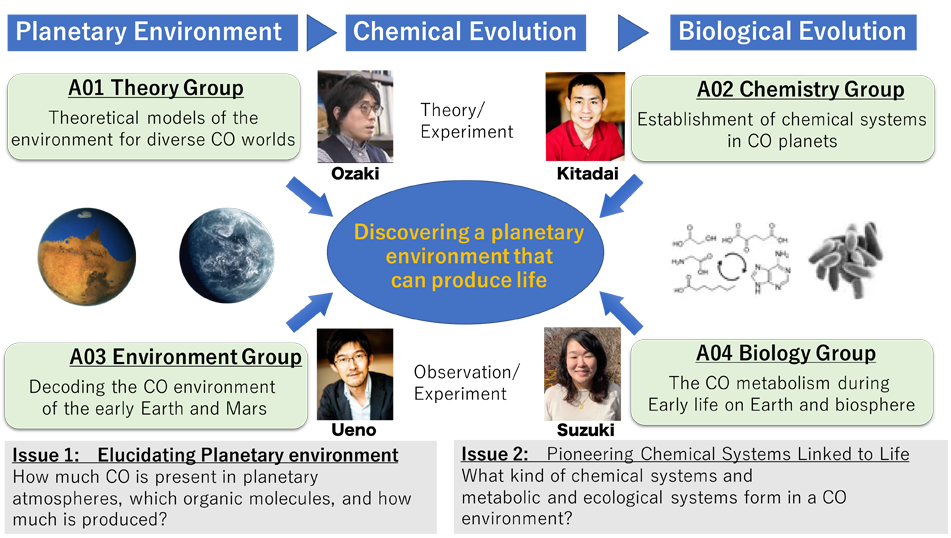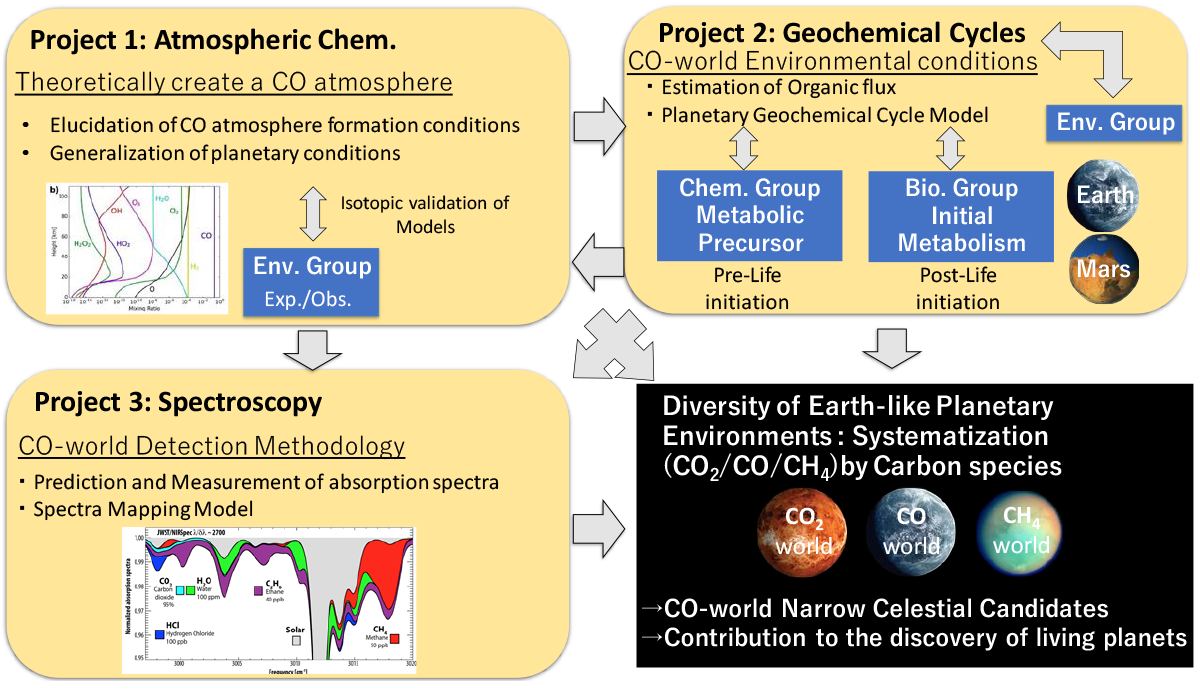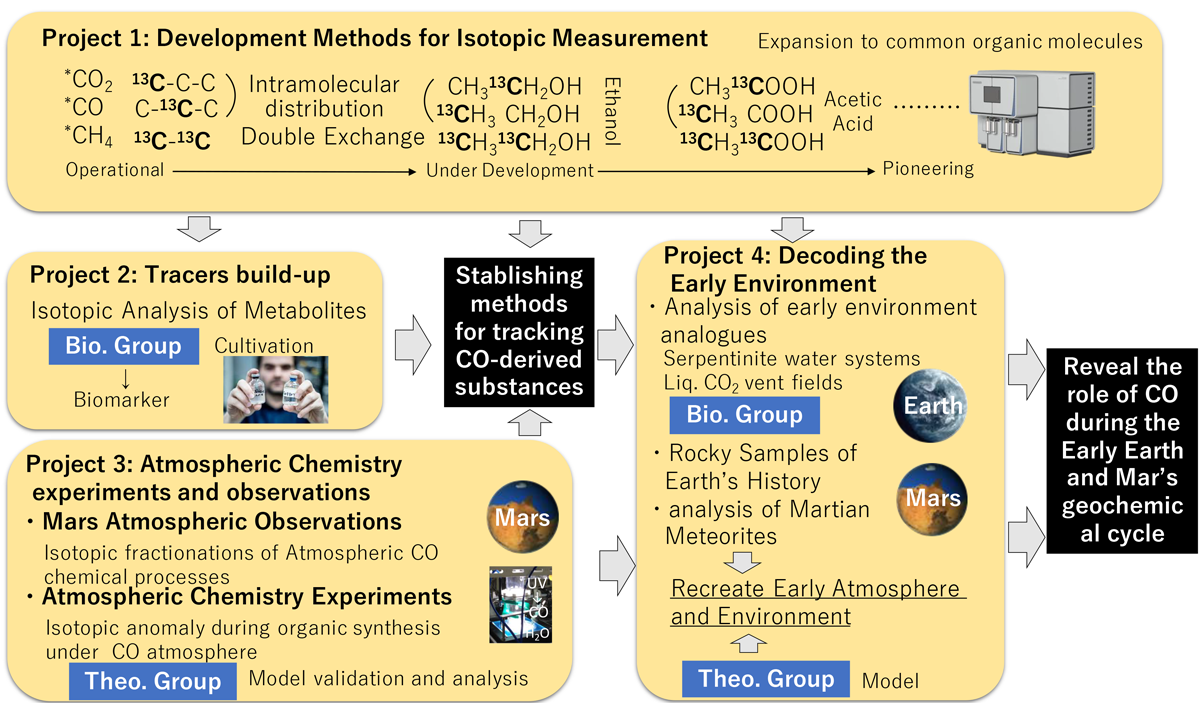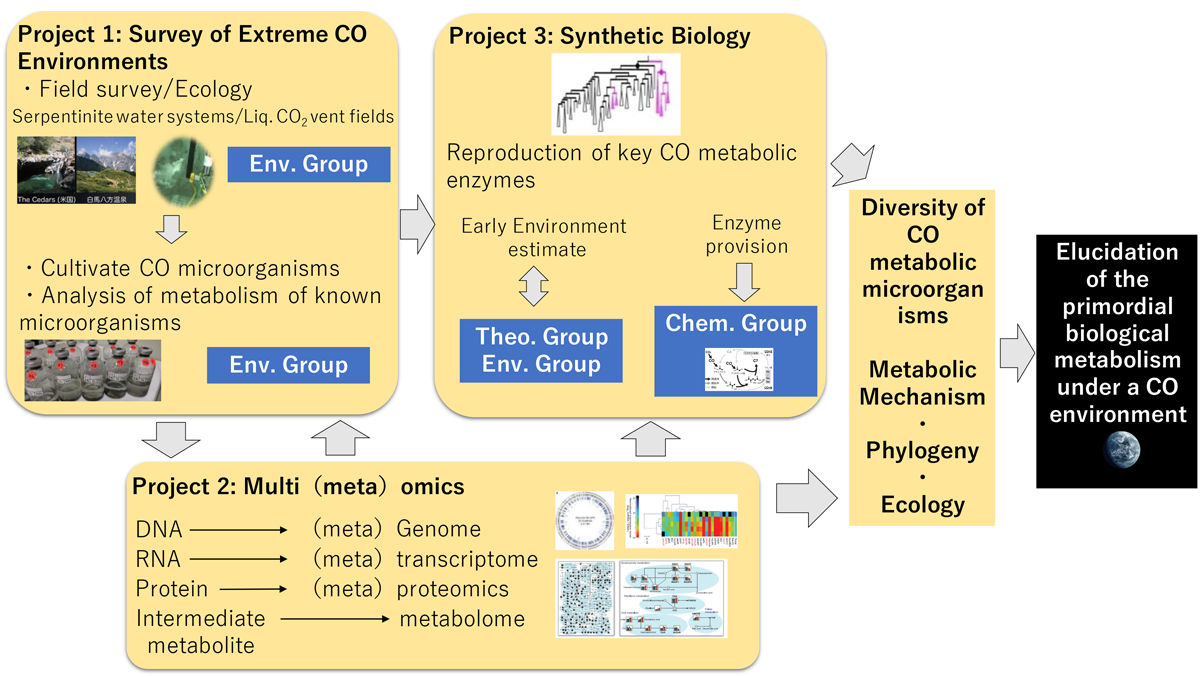Geochemistry of CO worlds
Why CO world?
This research field aims to elucidate the planetary environmental conditions necessary for life emergence. This research plan to generate breakthroughs by promoting interdisciplinary research on the planetary environment (CO world) in which organic molecules are generated from carbon monoxide CO. Astronomical observations and planetary exploration have so far discovered a series of bodies other than the Earth that are capable of life activity, and observations aimed at discovering traces of life on these bodies have already begun. However, the fundamental question of what kind of planetary environment is necessary for the birth of life remains unanswered. The fundamental question of what kind of planetary environment is necessary for the birth of life, however, remains unresolved. In this field, we aim to systematize the diversity of planetary environments caused by differences in the major carbon species (CO2/CO/CH4)according to their redox states. Among them, CO-rich environments are suitable for the synthesis of diverse organic molecules. On the other hand, it is also extremely interesting for the early metabolism of terrestrial life that only the acetyl CoA pathway, which is considered to be the oldest carbon fixation pathway, can utilize CO as a carbon source in terms of microbial metabolism. In addition, recent theoretical predictions of the presence of CO in the early Earth and Martian atmospheres, and geochemical evidence for its presence, have been found.

Working hypothesis: Precursor metabolism established in CO world
Our Approach
This project will focus on CO world research, which has been conventionally overlooked, will be accomplished through the fusion of four academic disciplines. A01 Theory Group and A02 Environment Group will elucidate how much CO exists in the atmospheres of Early Earth, Mars, and other exoplanets, and which organic molecules are produced from CO, based on theoretical models of planetary atmospheres and material cycles, and geochemical observations and experiments using isotopic molecules, etc., respectively. On the other hand, A03 Biology Group and A04 Chemistry Group will clarify what kind of ecosystems and chemical reaction systems will be established under such planetary environments. The existence of organic molecules as materials is not enough to create life. Rather, a system of reactions in which those material molecules are constantly produced must exist in the environment. By focusing on CO, this field plans to demonstrate that chemical systems that lead to life metabolism (precursor metabolic systems) can be established in the real planetary environment. Through this interdisciplinary effort, we will also provide concrete methods to identify traces of life in future astronomical observations and planetary exploration, thereby bringing about a revolution in the field.

Working hypothesis: Precursor metabolism established in CO world
From an inert Planet to Life
What kind of planetary environment would be necessary to produce life? Chemical systems similar to the central metabolism of present-day organisms could have been driven initially by inorganic catalysts provided by the Earth, instead of enzymes. Such chemistry is called precursor metabolism; in the CO world, one would expect the precursor metabolic system to be continuously driven by the aldehydes and organic acids that are continually produced from atmospheric CO. When this reaction system generates the molecules that make it up itself, an autocatalytic cycle is established and molecules such as amino acids are produced more efficiently. If these further polymerize and become active, they can replace the inorganic catalyst and this chemical system itself can gradually become self-sustaining from the environment. In this project, we will approach the origin of life by constructing a chemical system that can be established in a planetary environment and lead to life (or is connected to life), as shown in the example above.

Working hypothesis: Precursor metabolism established in CO world
Research Groups
A01 Theory Group:Modeling of planetary CO environments
The theory group purpose is to understand the diversity of terrestrial planetary environments according to the redox state of carbon in the atmosphere(CO2/CO/CH4) from a theoretical perspective based on (bio)geochemistry and establish a theoretical basis for the search for life-hosting planets (life planets) using next-generation telescopes. In particular, the group will elucidate the formation fluxes and environmental conditions of organic compounds that are important for the precursor metabolism of life in planetary atmospheres that are mainly composed of CO. In addition, the group aims to verify the detectability as an exoplanet and to gain a comprehensive understanding of planetary CO environments. Specific goals include:
1) elucidation of the physicochemical conditions under which terrestrial planets have CO atmospheres
2) quantitative evaluation of material cycling processes occurring in planetary CO environments as typified by early Earth and early Mars
3) comprehensive understanding of the spectroscopic properties of CO2/CO/CH4 atmospheres
4) Comprehensive understanding of the spectroscopic properties of CO2/CO/CH4 atmospheres and establishment of detection methods for planetary CO environments.

A02 Geochemistry Group: Deciphering CO Geochemistry on Early Earth and Mars
The Geochemistry Group will reconstruct the early environments of Earth and Mars. In order to decipher past atmospheric chemistry, biological activities, and inorganic synthesis processes that cannot be directly observed, the Geochemistry Group will develop stable isotope ratio measurement methods at the molecular level (isotope molecular measurement). The group will characterize the isotopic molecular composition of organic molecules produced by atmospheric, biological, and chemical processes, and establish indicators (biomarkers) to discriminate between organic molecules produced from CO by atmospheric chemistry and biological processes. The chemical processes of atmospheric CO will be elucidated through observations of the Martian atmosphere and photochemical experiments in the laboratory, and the organic molecules supplied by the CO atmosphere and their isotopic fractionation will be characterized. In addition, the biological processes will be observed in the extreme CO environment in collaboration with the biology group, and isotopic molecular measurements will be applied to elucidate the material cycle in the early terrestrial analog environment and to demonstrate the usefulness of the biological indicators. Using the above isotopic indicators and the atmospheric model constructed in collaboration with the theory group, we will analyze isotopic anomalies of organic molecules in Earth’s historical rock samples and Martian meteorites to elucidate material cycles on the early Earth and Mars, starting from atmospheric CO, and decipher their early planetary environments, including the presence or absence of life.

A03 Biology Group: Elucidation of how the biosphere was established in a CO environment
The Biology Group will expand our knowledge of CO-driven microorganisms, which is still largely unknown, and approach the primitive CO-driven metabolism of life. Our understanding of microbial CO metabolism is still in its infancy stage because the CO environment is rare for our oxygen-rich planet. In this project, we will conduct field studies in two extreme CO environments with different redox levels, a super-reduced serpentinite system in which non-living CH4 and CO coexist, and a deep-sea liquid CO2 pool environment in which CO2 and CO coexist, in paleo-environmental analogs that remain in the current global environment. Field investigations will be conducted. By conducting their omics analysis, isolation culture and metabolic analysis of novel CO-metabolizing microorganisms, and evolutionary analysis, we will present the diversity of processes leading to energy metabolism, carbon fixation, and biomolecular synthesis in CO-driven life, and systematically clarify the etiology, characteristics, and environmental constraints of CO-driven microbial metabolism. Based on these findings, we will identify enzymes and pathways that serve as the interface between the CO environment and life, create and analyze them using synthetic biology and biochemical methods, and clarify their characteristics. Integrating these findings, we will elucidate the reality of organism-environment interactions in the CO environment, and present how primitive life metabolism proceeded in any CO environment.

A04 Chemistry Group: Finding a precursor metabolic system driven by a CO environment
The Chemistry Group will theoretically pursue the autocatalytic networks (precursor metabolism) that are established in planetary environments starting from CO and demonstrate them through experiments. First, from the mathematical model, candidate combinations of reaction steps and numerical targets of reaction selectivity necessary for the occurrence of autocatalysis are derived. Based on this design, experiments will sequentially explore organic acid formation routes using CO and its derivatives as carbon sources, and amino acid/peptide/nucleobase formation routes using N2 and nitric acid as nitrogen sources. In addition, amino acid/peptide-mineral complex catalysts will be developed and used to improve reaction selectivity. Furthermore, we will develop a flow reactor that drives multiple steps in a cascade manner and look for an autocatalytic network as a series of systems by linking the elementary reactions pioneered in the experiments. In collaboration with the biology group (A03), we will receive information on primitive CO metabolism, and if there are reaction steps that are difficult to realize immediately, we will use pseudoenzymes produced by synthetic biology methods (top-down approach). On the other hand, as a bottom-up approach, we will simulate the CO environment derived by the Theory Group (A01) and the Environment Group (A02), and demonstrate the planetary chemical process in which building blocks of life, such as amino acids and nucleobases, are continuously generated from simple inorganic substances containing CO.
